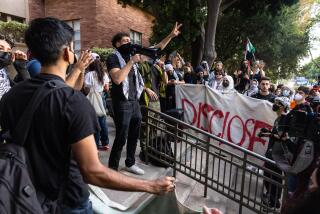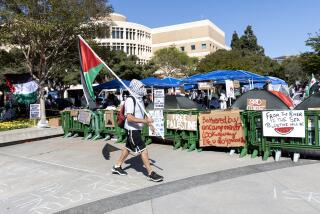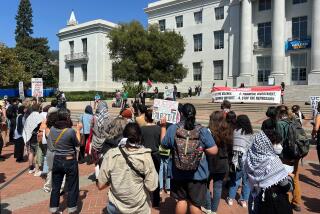âActivists werenât long-haired freaks, but people who saw that some things were wrong and were moved to change them.â : Ex-Athlete Chronicles â60s Protests at CSUN on Video
Today the campus of California State University, Northridge, is quiet, its lawns green and manicured. There is little to hint that the school has had a tumultuous past.
But, 17 years ago this month, the campus--then known as San Fernando Valley State College--was in turmoil. Black students had occupied the administration building and taken hostages, demanding that the school hire more minority teachers and establish ethnic-studies programs. Police later arrested more than 30 students.
Two months later, in January, 1969, another large demonstration ended at the administration building in a violent confrontation with police. The next day, defying a university-imposed ban on public gatherings, several thousand students rallied again. More than 200 protesters were arrested, all of them peacefully.
In a story that ran in March, 1969, the Los Angeles Times called the campus a âhotbed of radical youth.â Life magazine published a lengthy feature about the uproar at Valley State, describing the situation as âpainfully familiar.â
Hourlong Documentary
Now this chapter of Cal State Northridge history is the subject of âThe Storm at Valley State,â an hourlong documentary video made by Paul Kulak, a 26-year-old resident of Reseda.
Lean and muscular, with sandy blond hair and blue eyes, Kulak looks more like the actor he once hoped to be than the political activist he has become.
As a child Kulak was, in his words, âa loser of a kid.â From kindergarten on, he remembers, he âjust didnât fit in.â At 16 he dropped out of high school, spent a year in a boysâ home in Chicago, then, in 1978, fled to Los Angeles.
For much of the next year, Kulak lived on the streets, sleeping, whenever possible, in hallways. He bounced from job to job--20 of them in two years, he estimates--until he began to worry that heâd be âstuck and paralyzed in a dead-end job for the rest of my life.â So he enrolled at Pierce College.
After reading a biography of Olympic decathlon champion Bruce Jenner, Kulak took up the javelin. Although he had never thrown one, he learned quickly. At 23, he was the National Collegiate Athletic Assn. Division II champion. By early 1984, he was ranked third in the United States, with a personal best of 270 feet, 10 inches. He set his sights on the Los Angeles Olympics.
Three months before the Olympic trials, Kulak injured his shoulder, shattering his chance to make the U.S. team. Although he acknowledges that he was disappointed, Kulak says now that he had already tired of competitive athletics. âIt was a game gotten out of hand,â he said. âIt was too self-centered, too narrow-minded.â
By last March, Kulak, then a junior at Cal State Northridge, had become interested in politics, particularly the peace movement, when he read an article in the campus newspaper, the Daily Sundial, about protests at Valley State in the 1960s.
It was, he thought, âa story that needed to be told.â And, not being the kind of person to sit idly by, he plunged into work on âThe Storm at Valley State.â
A theater arts major, Kulak had never worked in video before, so he recruited Scot Kelly, a UCLA film student who worked as an intern at Valley Cable Television, to operate the camera and help with editing.
Kulak raised $2,000 in grant money from Cal State Northridgeâs Pan African Studies Department, the student government and the campus branch of Alliance for Survival, a peace group. Valley Cable offered a discount on the camera rental and free editing facilities in return for permission to air the video on its community access station.
Working with a minuscule budget and limited access to source photographs or film footage, Kulak had little choice but to keep his documentary simple. He expected to finish in three months.
Seven months later, âThe Storm at Valley Stateâ would tell its story in a straightforward manner, through the voices of those who participated in the protests.
The first half of the documentary concentrates on the minority students who transformed Valley State. By the fall of 1968, minority-student enrollment at the college had increased tenfold over the previous semester. Minority students and their white supporters demonstrated frequently against what they perceived as racism and a curriculum that ignored the needs and cultures of blacks and Chicanos.
The second half of the documentary focuses on the campus anti-war movement. The most dramatic moments of this section are recollections from May, 1970, when National Guardsmen shot and killed four students at Kent State University in Ohio. At Valley State, students protested that violence by forcing the school to close.
âIt meant that they were killing us,â Mike Lee, a former Valley State student, says in the documentary. âNo longer did we think that we were somehow protected. And so it woke us up to the fact the government considered us the enemy. . . . By the next day, when students heard about the shooting at Kent State, we were already on strike.â
Open Forum
In the 1960s and early 1970s, the focal point of turmoil at Cal State Northridge was a bare concrete platform on the southeast corner of campus known as the Free Speech Area or the Open Forum.
âOne reason the campus exploded,â Kulak said, âwas the Open Forum. It was close to the bookstore and the cafeteria, two centers of student life. Two, three or four times a week, people got an education, whether they were interested or not, about the war, civil rights and the movement.â
Today even the Open Forum has been demolished. All that remains from the â60s are the Pan African and Chicano Studies Department, created at the height of student unrest.
Kulak speaks almost mystically of his activism, as though it were something he was destined to do. He has taken this year off from school and may participate in a walk through Central America to focus public attention on the wars in that region.
But he doesnât wish so much that he had lived in the 1960s as he wishes that âthe spirit of the â60sâ--the willingness to become involved, to challenge the status quo--were alive today.
âI could make 20 movies, full-length feature films, about the â60s and never run out of material,â Kulak said. âThe intent of the video was to show people that activists in the â60s werenât long-haired freaks, but people who saw that some things were wrong and were moved to change them.â
Kulak is fond of comparing the 1980s to the 1950s and of emphasizing how the â50s quietly prepared young people to rebel. âThereâs no doubt that weâre in an extremely conservative trend right now,â he said. âBut the experiences of the â60s have not been lost. We saw a real increase in activism last semester, and it seems to be getting going again this semester.â
No Illusions
Kulak holds no illusions about the power of a single, low-budget documentary to change the world. âLetâs face it,â he said, âsome students will listen to this and will be moved and motivated to do something. With others, it doesnât matter if they see a hundred hours of videotapes, theyâre not going to care.
âI hope I can reach those students who are already thinking in a certain way and move them to do more. I canât convince the whole world.â
âThe Storm at Valley Stateâ will be shown every Tuesday and Thursday through Dec. 15 at noon and 1 p.m. in Room 30-D of Oviatt Library at Cal State Northridge.
More to Read
Sign up for Essential California
The most important California stories and recommendations in your inbox every morning.
You may occasionally receive promotional content from the Los Angeles Times.










